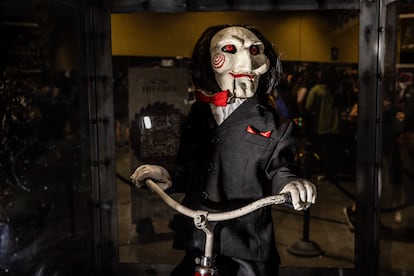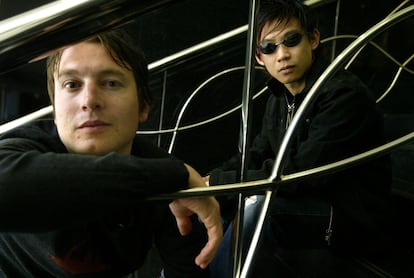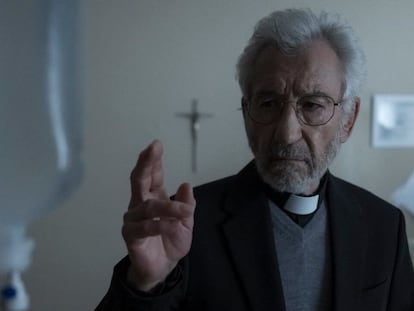Extremely violent, cruel and uncomfortable: How ‘Saw’ became a 21st century phenomenon
The most popular horror franchise of the past two decades returns to theaters seven years after its last installment. As usual, it promises to give its audience everything they want


When Australian filmmaker James Wan defends the Saw series, his life’s work, the cornerstone of his empire, he often resorts to an intuitive gastronomic analogy. It’s not sirloin steak. It’s not steak tartar. It’s not beef entrecôte. It is a hamburger. Burgers are generously seasoned, processed pieces of meat and are usually served with large amounts of mustard and ketchup. People like them. But they are not fine dining.
Wan has always described himself as a voracious cinephile with a rather coarse palate, a consumer of gory flicks, slasher movies, giallo films and all manner of irreverent horror films, from Black Christmas (1974), Halloween (1978), The Ring (2002) and Braindead (1992) to Blood and Black Lace (1964) and The Texas Chainsaw Massacre (1974). Privately, he has a place in his heart for Hitchcock’s Vertigo and Walt Disney’s Snow White and the Seven Dwarfs (I), but his influences are primarily people who are none-too-subtle and carry heavy caliber ammunition in their cartridge cases. His heroes are guys like Tobe Hoper, Mario Bava and Hideo Nakata.
That’s the film diet the Malaysian-born Australian, now 48, has consumed since he was a teenager. It’s also the kind of movie he set out to make — when he was just 20 years old and still a student at the Melbourne Institute of Technology — with his partner and friend Leigh Whannell, an enthusiast of “zombies, monsters, serial killers, grotesque and sappy horror and Hollywood action blockbusters.” As Andrea Albin recounts in a sympathetic Bloody Disgusting article, Wan and Whannell resisted the fine steaks — intellectual and auteur films — their professors and fellow students tried to get them to appreciate. But they could never stomach Godard. They always knew that their films would be raw, unadulterated fast-food cinema. And so they tried to sell that, first to a series of Australian independent production companies and eventually to Hollywood studios.

Wan and Whannell produced the first of their flicks nearly twenty years ago, in 2004. As Chris Coffel explains in the blog Film School Rejects (III), shortly after landing in Los Angeles, the twenty-something Australians won over Lions Gate, which delivered a million dollars and a couple of high-profile performers, Cary Elwes and Danny Glover, and gave them 18 days to try to turn the script they had brought back from Australia —the curious story of a homicidal maniac bent on subjecting his victims to intricate and cruel sociological experiments — into a film that was “at least palatable.”
A feast of blood and gore
Despite its intense appetite for fresh blood — it’s not suitable for the faint of heart — and meager budget, the first Saw was an overwhelming and unexpected hit that showed Wan how in tune the public was with his taste. What’s more, the movie served to revitalize a horror genre that, at the time, was at a low point and helped popularize one of the most controversial and reviled categories in the history of cinema: torture porn, which is synonymous with explicit extreme violence with an added dose of psychological cruelty.
Ross Tibs, editor of Far Out Magazine, considers the film to be “brave” and disruptive. A more than worthy product in its assumed modesty, the movie also gave cinema “a timely mix of philosophy, psychology and extreme physical violence,” thus paving the way for Eli Roth’s Hostel (2005). For Tibs, “these films brought back the logic of ‘go see it if you dare’ that had been anticipated by the most hard-core classics of horror released in the 1960s and 1970s,” from The Texas Chainsaw Massacre to I Spit on Your Grave and The Last House on the Left.
In a way, this demented ultraviolence energetically reclaimed the right to “surprise, horrify and shock” an audience that had already grown accustomed to the great contemporary horror franchises, like Nightmare on Elm Street and Friday the 13th, which were falling into self-parody and becoming increasingly bland and innocuous. The genre had become indoctrinated and was crying out for a jolt to avoid losing its immediacy and relevance. With all its virtues and flaws, Saw provided a jolt.
‘Cruelly empty’?
Of course, not all critics were taken by Wan and Whannell’s gorefest. On the contrary, reviews of the film ranged from skeptical to furious. It had plenty of detractors and found few allies in the press. David Germain of the Associated Press called it “vicious to no end,” and was outraged by its “cruelly empty” script and “clumsy” mise-en-scène, lamenting that actors of some standing like Elwes and Glover had compromised their reputations by participating in such nonsense. Germain concluded that the director and screenwriter were a pair of talentless opportunists who had attempted to dress up something that was nothing more than a degrading display of perversion and stupidity as a morality tale.

Peter Travers, of Rolling Stone, needed just three lines to pan Wan for his “creepy” display of unscrupulousness and bad taste. Mike Clark, of USA Today, felt that the film engaged in constant assaults on sanity and the most basic sense of ethics, and that it did so through “shamelessness” rather than true cinematic skill. Scott Tobias, of AV Club, considered the movie to be the epitome of imbecility, starring a “random freak pulled out of the screenwriter’s ass.”
Of the rare praise in the first reactions, The Guardian’s Peter Bradshaw, found the film to be “an unhealthy and eccentric atmosphere” worthy of cruel thrillers like Seven. In Entertainment Weekly, Owen Gleiberman chose to be condescending, observing that, beyond its nightmarish atmosphere and commitment to unadulterated physical horror, the movie had a remarkable ability to entertain the audience without insulting its intelligence (at all).
Count to ten
Two decades later, the film that Gleiberman considered to be honest in its own way — an atrocious movie without much ambition, whose success he never would have predicted — has eight sequels with earnings of between $40 million and $169 million; the franchise is about to premiere its tenth installment, Saw X, which opens on September 29. The latest installment is directed by Kevin Greutert, who also made Saw VI and served as editor on up to six of the franchise’s installments. Saw X brings back the original villain, John Kramer, also known as Jigsaw (played, once again, by the very competent Tobin Bell), the cancer patient whose resentment and excessive attachment to life have turned him into a twisted and merciless predator.
In a telling Reddit thread about what to expect from Saw X, fans of the franchise are more than willing to take the bait again and go to the cinema as enthusiastic as ever, but they have a number of conditions for the film. The first is that they don’t want “a new disciple and apprentice psychopath,” a plot device that has been abused since Kramer died at the end of the third installment. Nor would they accept “an excessive use of computer-generated visual effects” (Saw has always boasted of a certain “handcrafted” style that makes its most violent scenes particularly shocking), the introduction of paranormal phenomena or the representation of the villain “as a kind of vigilante and not as the bitter, moralistic and hypocritical individual he has always been.” If none of these things happen, they are all for the new movie.
Reading those comments, it is clear why Saw has not lost its ability to connect with its natural audience, mostly men between 18 and 25 years old. The installment has established a solid pact with its community of unconditional followers because it gives them what they want. It has understood their expectations and dedicated itself to satisfying them without denaturing the product. The red lines are clear: the coherence of characters and situations must be maintained; the violence should not be reduced, even though this particular ingredient makes it hard to accommodate in many cinemas; a certain level of verisimilitude and realism must remain, without falling into carnivalesque excesses; the sordidness and macabre humor must be retained, and, finally, while the quality of the script has deteriorated, the film must keep its ingenuity and capacity to surprise and not abuse previously used devices.
James Wan directed, co-wrote and produced the film that launched the franchise. He was also the one who made Saw 0.5, the short film — it’s just nine and a half minutes long — that started it all, now a cult classic, which was shot in a couple of days with a 16 mm camera for just over $2,000. Since then, Wan’s involvement in the franchise has been limited to participating in writing the Saw III script and serving as executive producer (along with Leigh Whannell) for all the other installments. The rest of the movies have been directed by the aforementioned Greutert and Darren Lynn Bousman, while the scripts have been written by different people, in a not-always-successful attempt to freshen things up and get ideas flowing. Saw’s creators have exercised increasingly distant quality control while embarking on other projects (Insidious, Anabelle, The Conjuring) and carrying the banner of revitalizing the horror genre in the process.
Through 2010, the Saw franchise continued its frenetic pace of releasing a new installment every year; they were always released in October to coincide with Halloween. Saw 3D, the seventh in the series, premiered as the final chapter that was set to end the story once and for all. And perhaps that would have been the case if its success at the box office (it earned $136 million and had a $17 million budget) had not made its directors reconsider the decision to kill the goose that lays the golden eggs.
Ultimately, the planned cancellation became a seven-year hiatus that served to rejuvenate the product. They launched the franchise again with Jigsaw (2017), an update directed by genre cinema’s new bluebloods, the Spierig Brothers. Jigsaw ended up following the same path as its predecessors: it garnered tepid to lousy reviews but enjoyed notable box-office success. That’s also what we can expect of the next installment of Saw, that is, unless the filmmakers have found a way to bring back our horrified amazement at Jigsaw’s first crimes.
Sign up for our weekly newsletter to get more English-language news coverage from EL PAÍS USA Edition
Tu suscripción se está usando en otro dispositivo
¿Quieres añadir otro usuario a tu suscripción?
Si continúas leyendo en este dispositivo, no se podrá leer en el otro.
FlechaTu suscripción se está usando en otro dispositivo y solo puedes acceder a EL PAÍS desde un dispositivo a la vez.
Si quieres compartir tu cuenta, cambia tu suscripción a la modalidad Premium, así podrás añadir otro usuario. Cada uno accederá con su propia cuenta de email, lo que os permitirá personalizar vuestra experiencia en EL PAÍS.
¿Tienes una suscripción de empresa? Accede aquí para contratar más cuentas.
En el caso de no saber quién está usando tu cuenta, te recomendamos cambiar tu contraseña aquí.
Si decides continuar compartiendo tu cuenta, este mensaje se mostrará en tu dispositivo y en el de la otra persona que está usando tu cuenta de forma indefinida, afectando a tu experiencia de lectura. Puedes consultar aquí los términos y condiciones de la suscripción digital.
More information
Últimas noticias
Petro claims the ELN was the target of US attack in Venezuela
Maduro counterattacks Trump with rhetoric and announces downing of nine drug trafficking aircraft
‘Ecce Homo’: The miraculous disaster that made a small Spanish town famous
Return to sex testing at the Olympics: IOC edges closer to banning transgender women
Most viewed
- Sinaloa Cartel war is taking its toll on Los Chapitos
- Oona Chaplin: ‘I told James Cameron that I was living in a treehouse and starting a permaculture project with a friend’
- Reinhard Genzel, Nobel laureate in physics: ‘One-minute videos will never give you the truth’
- Why the price of coffee has skyrocketed: from Brazilian plantations to specialty coffee houses
- Silver prices are going crazy: This is what’s fueling the rally










































